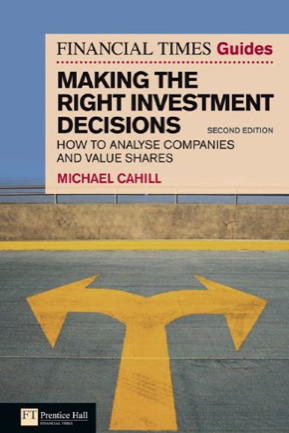My review of Michael Cahill’s thought-provoking book, Financial Times Guide to Making the Right Investment Decisions: How to Analyse Companies and Value Shares first appeared on Amazon 21st February 2011.
As to be expected Michael covers the major concepts, ratios and models used by the investment industry in determining the absolute and relative valuation of company shares. The insights he brings from his experiences as a sell-side equity analyst, an executive coach and trainer distinguish his writing. These perspectives enable him to go beyond the accepted wisdom to explain the nuances and complexities of managements and businesses across a range of industries. He uses commons sense and an intuitive approach in his explanations. The seasoned investor and the novice alike will benefit from reading this book.
Michael demonstrates that a blind faith in numbers or ratios can disguise what is really happening to the health and long-term prospects of a business. Also accounting distortions can give a much rosier picture of the underlying situation and the company’s ability to generate cash. He cautions against excessive reliance on sophisticated mathematical models, which don’t capture the vagaries of human behaviour and the real world. Further he challenges the industry’s tendency over the last decade to focus narrowly on growth without adequate consideration of how the growth is being funded and the attendant business and financial risks.
Michael devises the `Valuation Villa’ framework to explore the key ingredients of growth, risk and quality in assessing a company’s potential to create sustainable wealth. He emphasizes the need to pay attention to all three and not to be swayed by one measure alone. He digs deeper by considering the management and strategy of the business, its financial position, the returns it generates and its outlook. This approach provides a more comprehensive understanding of what drives value. He also outlines the thinking of some influential writers and investors such as Warren Buffet, Michael Porter and Jim Collins
In considering the quality of management Michael explores corporate values, governance and cultural aspects. He points to the folly of managements managing share price or earnings rather than focusing on the business. Their attention to targets can distort their decision-making and their long-term prospects. In addition a narrow goal to maximize shareholder returns through growing earnings without also taking into account other stakeholders will prove a pyrrhic victory. The example of Enron and its contrast to Apple highlights these issues.
The book is well organized and easy to read. Michael provides helpful summaries, checklists and a glossary of terms. I only wish that when I was a fund manager I had had access to this work. It would have assisted my analytical process and sharpened my money-making abilities whilst taking account of broader issues and multiple stakeholders.

